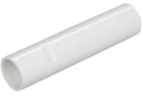I'm planning to run some 20mm PVC conduit along an external wall to supply power to an outbuilding.
I appreciate that when run externally the various conduit fittings should be glued on to prevent water getting inside the conduit (this is in the peak district so there could be a lot of water coming down from the sky!).
However, I need an expansion joint as I have a long horizontal run. By its very nature you can't glue that on at both ends or it won't work.
How do I make the expansion joint water tight? - Or don't people bother?
(I've heard of non setting conduit glue but can't seem to find any)
If it's a hassle then I'll just use metal conduit.
I appreciate that when run externally the various conduit fittings should be glued on to prevent water getting inside the conduit (this is in the peak district so there could be a lot of water coming down from the sky!).
However, I need an expansion joint as I have a long horizontal run. By its very nature you can't glue that on at both ends or it won't work.
How do I make the expansion joint water tight? - Or don't people bother?
(I've heard of non setting conduit glue but can't seem to find any)
If it's a hassle then I'll just use metal conduit.
Last edited:


